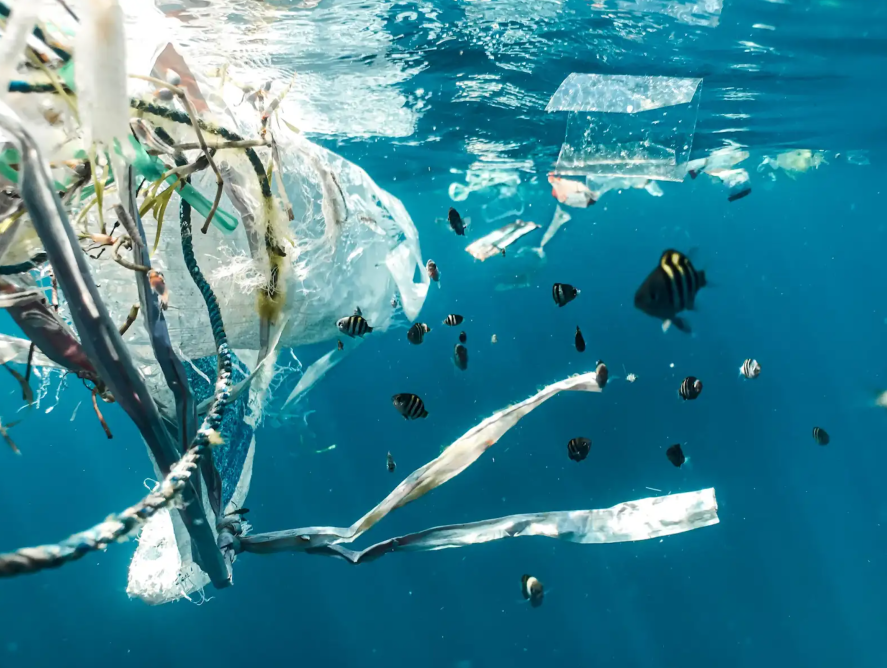Take a minute and imagine a future where our oceans contain more plastic than fish. This bleak scene could become our reality by the year 2050 due to ocean pollution (13). Ocean pollution, which occurs when materials such as plastic, oil, chemicals, agricultural waste, and industrial waste are released into the ocean, is degrading water quality and harming marine life at an unprecedented scale.
According to GreenMatch, a solar energy company in England, a major contributor to this dire environmental problem is run-off and the discharge of nutrients, which accounts for 80% of world-wide ocean pollution. Agriculture, urban, and industrial run-off all include nitrogen and phosphorus. When run-off enters the ocean, it increases the growth of algal blooms. As a matter of fact, research has shown that harmful algal blooms have tripled since 1984 (13). These algal blooms produce toxins that are harmful to surrounding wildlife, such as fish, mammals, and birds. The overgrowth of algae consumes the oxygen in the water and blocks the sunlight from the plants underneath. When the algae finally starts to decompose, they consume the oxygen in the water column. These excessive amounts of algae can lead the levels of dissolved oxygen to decrease rapidly, ultimately causing what are called “dead zones,” areas in ocean waters where no organisms are able to survive. Furthermore, dead zones can be created due to dangerous non-biodegradable and industrial substances which accumulate in water sediments. The accumulated substances can cause oxygen depletion and/or the release of toxins, ultimately causing organisms to become ill and possibly die. So far, scientists have found around 500 dead zones around the globe, proving that we must address the ongoing issue of run-off before it further destroys our oceans (3).
While agricultural and industrial run-off pose a threat to marine life, sewage pollution further aggravates the issue by introducing more waste into bodies of water. Sewage pollution occurs when a country has inadequate sanitation and wastewater facilities. An example of sewage pollution is when the absence of water treatment causes untreated sewage to flow into bodies of water. Across the globe, aging infrastructures are being neglected and, as a result, causing frequent infrastructure failures and sewage spills. Additionally, sewage systems can become overused as cities become more populated, which in turn can lead to failures happening more frequently. In addition to these frequent failures, when heavy rain takes place, combined sewer systems – those which operate both sewage and stormwater – can overflow, ultimately releasing untreated sewage into bodies of water. The global issue of sewage pollution highlights the critical need to invest in resilient sewage systems in order to protect our oceans.
Another culprit in ocean pollution is, unsurprisingly, plastics. Currently, there is approximately 75 to 199 million tons of plastic waste in our oceans, with around 14 million more tons of plastic entering the ocean each year (13). Plastics play a large role in polluting our oceans and they can enter waters for a variety of reasons. For instance, litter, whether purposeful or accidental, can end up in the ocean due to heavy winds and rain. Waste from overflowing trash bins can be blown into nearby waterways. Cargo containers, often containing plastics, are also sometimes lost at sea. These containers can open and spill their contents into the ocean. Landfill leakages also contribute to the plastic waste in the ocean. It goes without saying that the abundance of plastic waste that ends up in our oceans negatively impacts marine wildlife. For example, organisms can ingest or get tangled in the plastic, causing them to become ill and potentially die, further disrupting ecosystems. Additionally, the plastic can introduce toxic chemicals to bodies of water, in turn causing predators to eat contaminated prey. According to the National Institute of Health, 67 species worldwide are impacted by ocean pollution. This includes 44% of birds, 43% of mammals, 86% of turtles and various fish species (17). On the other hand, plastics in the ocean pose a threat to human health as well. The already alarming rate at which humans consume microplastics is steadily increasing. Research has shown that an average person will eat 53,864 particles of plastics each year, which is equivalent to 17 credit cards (8). The staggering amount of plastic in our oceans, in addition to the ever-growing amount of new plastic pollution, highlights the urgent need for a solution to this crisis.
As underscored above, the threats from agricultural run-off, sewage contamination, and plastic waste demand urgent action. By implementing stricter regulations and innovative solutions, we can work towards restoring ocean health. We would benefit from taking more personal responsibility by reducing our plastic usage, supporting policies that improve waste management, and spreading awareness about the importance of ocean health. Together, we can make a significant impact and guarantee a healthier future for our oceans.
Works Cited
- “3 Reasons Why Plastic Is Leaking from Land to Ocean.” Plastic Bank, 5 Sept. 2024, plasticbank.com/blog/3-reasons-why-plastic-is-leaking-from-the-land-to-the-ocean-in-indonesia/#:~:text=Marine%20animals%20ingest%20plastic%20pollution,microplastics%20entering%20the%20food%20chain.
- Davison, Tamara. “How Much Plastic Is in the Ocean?: Stats.” CleanHub, Cleanhub, 14 May 2024, blog.cleanhub.com/how-much-plastic-in-the-ocean#:~:text=How%20much%20plastic%20is%20in%20the%20ocean%20in%202024%3F,sitting%20on%20the%20sea%20bed.
- “Dead Zone.” Education, education.nationalgeographic.org/resource/dead-zone/. Accessed 30 Sept. 2024.
- Denchak, Melissa. “Water Pollution: Everything You Need to Know.” Water Pollution Definition – Types, Causes, Effects, 11 Jan. 2023, www.nrdc.org/stories/water-pollution-everything-you-need-know#whatis.
- “The Effects: Dead Zones and Harmful Algal Blooms.” EPA, Environmental Protection Agency, www.epa.gov/nutrientpollution/effects-dead-zones-and-harmful-algal-blooms#:~:text=Excess%20nitrogen%20and%20phosphorus%20cause,in%20the%20water%20is%20consumed. Accessed 30 Sept. 2024.
- Emilypeterson. “Read the Ocean Sewage Pollution Primer on Our Shared Seas.” Our Shared Seas, 4 Dec. 2022, oursharedseas.com/sewage-pollution-primer/#:~:text=Sewage%20pollution%20enters%20the%20ocean,lead%20to%20combined%20sewer%20overflows.
- happy_turtle_2021. “Everything You Need to Know about Plastic Pollution and the Ocean.” The Happy Turtle Straw, 9 Mar. 2022, www.thehappyturtlestraw.com/everything-you-need-to-know-about-plastic-pollution-and-the-ocean/..
- Higgins, Grace. “You Are What You Eat: Plastics in Our Food.” Earth Day, 6 Feb. 2024, www.earthday.org/you-are-what-you-eat-plastics-in-our-food/#:~:text=When%20eating%20an%20oceanic%20creature,equivalent%20to%2017%20credit%20cards.
- “How Does Industrial Waste Get into Water Systems?” H2O GmbH, www.h2o-de.com/en/blog/how-does-industrial-waste-get-into-water-systems-and-what-are-its-effects#:~:text=Many%20of%20the%20hazardous%20substances,Biodiversity%20suffers. Accessed 30 Sept. 2024.
- “How Does Plastic Get into the Ocean?” IFAW, www.ifaw.org/journal/plastic-pollution-ocean#:~:text=Littering%20. Accessed 30 Sept. 2024.
- “Marine Pollution.” One Ocean, 29 Nov. 2019, www.oceanprotect.org/resources/issue-briefs/marine-pollution/#:~:text=It%20can%20change%20the%20physical,and%20can%20impact%20human%20health.
- Montanari, Shaena. “Your Lost Shipment Could Be Trashing a Beach Thousands of Miles Away.” Popular Science, 11 May 2021, www.popsci.com/environment/shipping-cargo-ocean-pollution/#:~:text=Hundreds%2C%20or%20even%20thousands%2C%20of,enter%20the%20ocean%20this%20way.
- “Ocean Pollution: Key Facts and Trends 2024 Update.” GreenMatch.Co.Uk, 8 Aug. 2024, www.greenmatch.co.uk/ocean-pollution-facts.
- Portilla, Nicolle. “Plastic Pollution in the Ocean – 2024 Facts and Statistics.” Recycle Track Systems, 30 Dec. 2023, www.rts.com/blog/plastic-pollution-in-the-ocean-facts-and-statistics/#:~:text=There%20is%20an%20estimated%2075,marine%20environment%20every%20single%20year.
- “Research Guides: Marine Pollution: Introduction.” Introduction – Marine Pollution – Research Guides at Central Community College, libguides.cccneb.edu/oceanpollution#:~:text=Pollution%20is%20defined%20as%20the,waste%20into%20the%20ocean%20waters. Accessed 30 Sept. 2024.
- “What Is a Harmful Algal Bloom?” National Oceanic and Atmospheric Administration, www.noaa.gov/what-is-harmful-algal-bloom#:~:text=Under%20the%20right%20conditions%2C%20algae,even%20death%20in%20extreme%20cases. Accessed 30 Sept. 2024.
- Ziani, Khaled, et al. “Microplastics: A Real Global Threat for Environment and Food Safety: A State of the Art Review.” Nutrients, U.S. National Library of Medicine, 25 Jan. 2023, www.ncbi.nlm.nih.gov/pmc/articles/PMC9920460/#:~:text=Plastic%20waste%20present%20in%20the,various%20fish%20species%20%5B29%5D.

